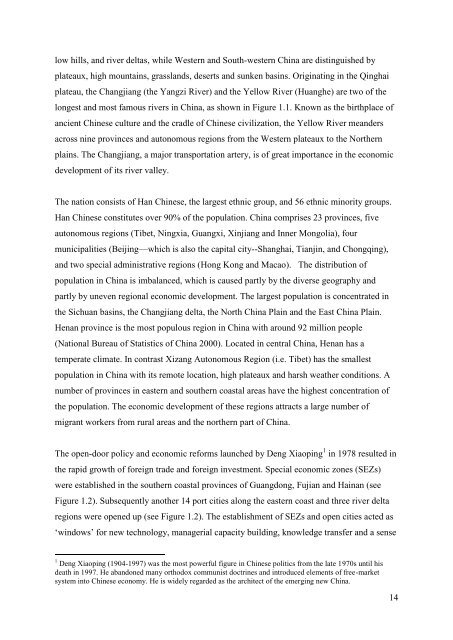The challenge of academic writing for Chinese students within ...
The challenge of academic writing for Chinese students within ...
The challenge of academic writing for Chinese students within ...
You also want an ePaper? Increase the reach of your titles
YUMPU automatically turns print PDFs into web optimized ePapers that Google loves.
low hills, and river deltas, while Western and South-western China are distinguished by<br />
plateaux, high mountains, grasslands, deserts and sunken basins. Originating in the Qinghai<br />
plateau, the Changjiang (the Yangzi River) and the Yellow River (Huanghe) are two <strong>of</strong> the<br />
longest and most famous rivers in China, as shown in Figure 1.1. Known as the birthplace <strong>of</strong><br />
ancient <strong>Chinese</strong> culture and the cradle <strong>of</strong> <strong>Chinese</strong> civilization, the Yellow River meanders<br />
across nine provinces and autonomous regions from the Western plateaux to the Northern<br />
plains. <strong>The</strong> Changjiang, a major transportation artery, is <strong>of</strong> great importance in the economic<br />
development <strong>of</strong> its river valley.<br />
<strong>The</strong> nation consists <strong>of</strong> Han <strong>Chinese</strong>, the largest ethnic group, and 56 ethnic minority groups.<br />
Han <strong>Chinese</strong> constitutes over 90% <strong>of</strong> the population. China comprises 23 provinces, five<br />
autonomous regions (Tibet, Ningxia, Guangxi, Xinjiang and Inner Mongolia), four<br />
municipalities (Beijing—which is also the capital city--Shanghai, Tianjin, and Chongqing),<br />
and two special administrative regions (Hong Kong and Macao). <strong>The</strong> distribution <strong>of</strong><br />
population in China is imbalanced, which is caused partly by the diverse geography and<br />
partly by uneven regional economic development. <strong>The</strong> largest population is concentrated in<br />
the Sichuan basins, the Changjiang delta, the North China Plain and the East China Plain.<br />
Henan province is the most populous region in China with around 92 million people<br />
(National Bureau <strong>of</strong> Statistics <strong>of</strong> China 2000). Located in central China, Henan has a<br />
temperate climate. In contrast Xizang Autonomous Region (i.e. Tibet) has the smallest<br />
population in China with its remote location, high plateaux and harsh weather conditions. A<br />
number <strong>of</strong> provinces in eastern and southern coastal areas have the highest concentration <strong>of</strong><br />
the population. <strong>The</strong> economic development <strong>of</strong> these regions attracts a large number <strong>of</strong><br />
migrant workers from rural areas and the northern part <strong>of</strong> China.<br />
<strong>The</strong> open-door policy and economic re<strong>for</strong>ms launched by Deng Xiaoping 1 in 1978 resulted in<br />
the rapid growth <strong>of</strong> <strong>for</strong>eign trade and <strong>for</strong>eign investment. Special economic zones (SEZs)<br />
were established in the southern coastal provinces <strong>of</strong> Guangdong, Fujian and Hainan (see<br />
Figure 1.2). Subsequently another 14 port cities along the eastern coast and three river delta<br />
regions were opened up (see Figure 1.2). <strong>The</strong> establishment <strong>of</strong> SEZs and open cities acted as<br />
‗windows‘ <strong>for</strong> new technology, managerial capacity building, knowledge transfer and a sense<br />
1 Deng Xiaoping (1904-1997) was the most powerful figure in <strong>Chinese</strong> politics from the late 1970s until his<br />
death in 1997. He abandoned many orthodox communist doctrines and introduced elements <strong>of</strong> free-market<br />
system into <strong>Chinese</strong> economy. He is widely regarded as the architect <strong>of</strong> the emerging new China.<br />
14


